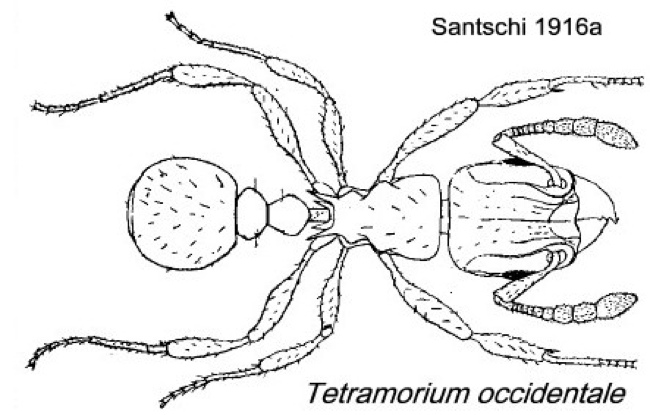Tetramorium occidentale (Santschi)
  Type location Cameroun
(Xiphomyrmex occidentalis n. sp., Santschi, 1916a: 50,
illustrated,
worker) no collection details - see below Type location Cameroun
(Xiphomyrmex occidentalis n. sp., Santschi, 1916a: 50,
illustrated,
worker) no collection details - see below
junior synonym insularis
(Xiphomyrmex insularis n. sp.,
Menozzi, 1924b: 223, illustrated, worker) from Principé Is. - no images on Antweb (April 2015)
worker only described (see Bolton, 1995)  . .
|
 Santschi's
(1916a) description is at Santschi's
(1916a) description is at  . Menozzi's (1924b) description of insularis
is at . Menozzi's (1924b) description of insularis
is at  .
Bolton's modern
description (1980) is at .
Bolton's modern
description (1980) is at  . .
Hita Garcia et al (2010)
have separated T.
akengense
(Wheeler, 1922: 194, worker) from Zaïre as a separate species
|
 WORKER - TL
2.3-3.3 mm; 11-segmented antennae; frontal
carinae ending at the level of the scrobe and not curving back and
down; petiole thickly squamiform. Largely unsculptured. Fine erect
hairs on all dorsal surfaces. Colour uniform dark brown to black,
appendages lighter, sometimes much lighter (Bolton, 1980, illustrated). WORKER - TL
2.3-3.3 mm; 11-segmented antennae; frontal
carinae ending at the level of the scrobe and not curving back and
down; petiole thickly squamiform. Largely unsculptured. Fine erect
hairs on all dorsal surfaces. Colour uniform dark brown to black,
appendages lighter, sometimes much lighter (Bolton, 1980, illustrated).
|
 From
West and Central Africa, described by Bolton (1980) as quite common in
thickly forested areas of Ghana, usually found in leaf litter
samples, with nests in rotten stumps and logs. Curiously, Belshaw &
Bolton (1994b) did not come across it in their many leaf litter
samples). Bolton listed collections from Ghana (C.A. Collingwood;
D. Leston; himself) at CRIG, Mampong, Pankese and Mt. Atewa. From Ivory
Coast, at Banco Forest (W.L. Brown) and Divo (C. Collingwood); and Cameroun,
the type location (not named) plus Yaoundé (E.S. Ross and K. Lorenzen)
and Muyuka (B. Malkin) (Bolton, 1980). Bernard (1952), recorded it (as X.
occidentalis) from Guinea, one worker being found at N'Zo;
adding that the "examples" (plural) differed from the type in being
truly black rather than brown-red and having the sides of the head and
thorax smooth (wrinkled, ?with rugulae?, in the type); a very variable
species but one of which it seemed useless to describe specific forms. From
West and Central Africa, described by Bolton (1980) as quite common in
thickly forested areas of Ghana, usually found in leaf litter
samples, with nests in rotten stumps and logs. Curiously, Belshaw &
Bolton (1994b) did not come across it in their many leaf litter
samples). Bolton listed collections from Ghana (C.A. Collingwood;
D. Leston; himself) at CRIG, Mampong, Pankese and Mt. Atewa. From Ivory
Coast, at Banco Forest (W.L. Brown) and Divo (C. Collingwood); and Cameroun,
the type location (not named) plus Yaoundé (E.S. Ross and K. Lorenzen)
and Muyuka (B. Malkin) (Bolton, 1980). Bernard (1952), recorded it (as X.
occidentalis) from Guinea, one worker being found at N'Zo;
adding that the "examples" (plural) differed from the type in being
truly black rather than brown-red and having the sides of the head and
thorax smooth (wrinkled, ?with rugulae?, in the type); a very variable
species but one of which it seemed useless to describe specific forms.
|
 The
photomontage is of the type worker collated from http://www.antweb.org/specimen.do?name=casent0915037. The
photomontage is of the type worker collated from http://www.antweb.org/specimen.do?name=casent0915037.
|
Oxford University Museum
specimens
Tetramorium occidentale
B Taylor det. |
Cameroun
A Fotso Kuate
Tetramorium occidentale
|
28.vii.2007
Awae II
03°54'30" N
11°25'58"
|
Quadrat in fallow
|
1
|
 |
Tetramorium occidentale
B Taylor det. |
Central African
Republic
P Annoyer
Di on reduviid
|
20.i.2005
Dzanga-Sangha
03°55’13.2" N
16°36’46.1" E
|
536m; U.V : 2h-6h,
après Sefka (entre Bambio et croisement Nola/Berberati),
dans layon forestier; from on a reduviid bug; collected in forest, 1st
hour of the morning
|
1
|
 |
|
 The photomontage is of a worker from Cameroun;
Awae II; collector A Fotso Kuate (fk
tetramorium occidentale) The photomontage is of a worker from Cameroun;
Awae II; collector A Fotso Kuate (fk
tetramorium occidentale)
|
 The
photomontage is of a queen from the Central
African Republic, Dzanga-Sangha National Park; from on a
reduviid bug; collected in forest, 1st hour of the morning; collector
Philippe Annoyer. The
photomontage is of a queen from the Central
African Republic, Dzanga-Sangha National Park; from on a
reduviid bug; collected in forest, 1st hour of the morning; collector
Philippe Annoyer.
This specimen matches the Santschi (1916a) description
exactly, including the brownish-black mandibles, antennae, legs and
extremity of the gaster; seen from above the petiole is oval, and the
postpetiole is globular, seen from above a little wider than the
petiole.
|
|